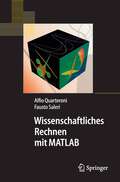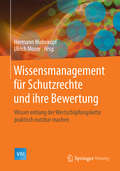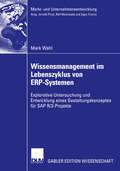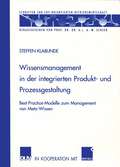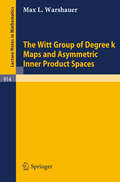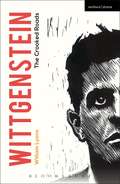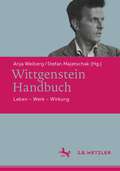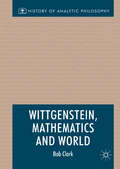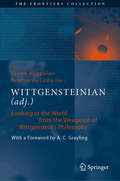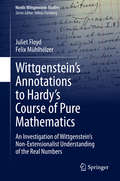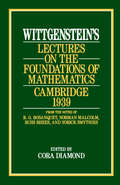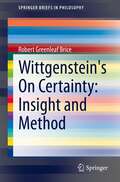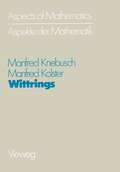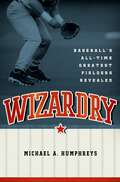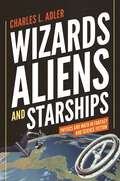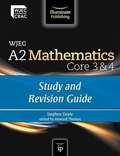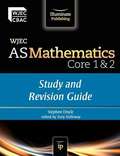- Table View
- List View
Wissenschaftliches Rechnen mit MATLAB (Springer-Lehrbuch)
by Alfio Quarteroni Fausto SaleriAus den Rezensionen der englischen Auflage: Dieses Lehrbuch ist eine Einführung in das Wissenschaftliche Rechnen und diskutiert Algorithmen und deren mathematischen Hintergrund. Angesprochen werden im Detail nichtlineare Gleichungen, Approximationsverfahren, numerische Integration und Differentiation, numerische Lineare Algebra, gewöhnliche Differentialgleichungen und Randwertprobleme. Zu den einzelnen Themen werden viele Beispiele und Übungsaufgaben sowie deren Lösung präsentiert, die durchweg in MATLAB formuliert sind. Der Leser findet daher nicht nur die graue Theorie sondern auch deren Umsetzung in numerischen, in MATLAB formulierten Code. MATLAB select 2003, Issue 2, p. 50. [Die Autoren] haben ein ausgezeichnetes Werk vorgelegt, das MATLAB vorstellt und eine sehr nützliche Sammlung von MATLAB Funktionen für die Lösung fortgeschrittener mathematischer und naturwissenschaftlicher Probleme bietet. [...] Die Präsentation des Stoffs ist durchgängig gut und leicht verständlich und beinhaltet Lösungen für die Übungen am Ende jedes Kapitels. Als exzellenter Neuzugang für Universitätsbibliotheken- und Buchhandlungen wird dieses Buch sowohl beim Selbststudium als auch als Ergänzung zu anderen MATLAB-basierten Büchern von großem Nutzen sein. Alles in allem: Sehr empfehlenswert. Für Studenten im Erstsemester wie für Experten gleichermassen. S.T. Karris, University of California, Berkeley, Choice 2003.
Wissensmanagement für Schutzrechte und ihre Bewertung: Wissen entlang der Wertschöpfungskette praktisch nutzbar machen (VDI-Buch)
by Hermann Mohnkopf Ulrich MoserUnternehmen benötigen das Wissen der Mitarbeiter, um Prozesse entlang der Produktentstehungs- und Wertschöpfungskette, in der Projektarbeit und Vereinbarungen mit Partnern, Zulieferern und Kunden konstruktiv nutzen zu können. Kundenbedürfnisse gilt es strukturiert festzuhalten und frühzeitig in den Prozess zu integrieren. Durch ein organisiertes Wissensmanagement können nicht nur langfristig kürzere Produktlebenszyklen, die Wissensintensität und die Aktualität des Wissens gesteigert und zielsicher und schnell verfügbar gemacht werden, sondern dadurch erfährt auch der Unternehmenswert eine Steigerung. Eine verkürzte Wertschöpfungskette im Unternehmen und ein schlankerer Produktprozess führen zur Erhöhung des Unternehmenswerts. Wie dieses Wissen in der Praxis erfasst, strukturiert, ständig auf dem Laufenden gehalten und jederzeit gut zugänglich gemacht wird, darüber berichten die Autoren.
Wissensmanagement im Lebenszyklus von ERP-Systemen: Explorative Untersuchung und Entwicklung eines Gestaltungskonzeptes für SAP R/3-Projekte (Markt- und Unternehmensentwicklung Markets and Organisations)
by Mark WahlMark Wahl untersucht, inwieweit IT-Projekte wie die SAP R/3-Implementierung in der Praxis durch Instrumente des Wissensmanagements ergänzt werden und erarbeitet Gestaltungsempfehlungen für ein zielgerichtetes Wissensmanagement bei der Abwicklung von IT-Projekten.
Wissensmanagement in der integrierten Produkt- und Prozessgestaltung: Best-Practice-Modelle zum Management von Meta-Wissen (Schriften zur EDV-orientierten Betriebswirtschaft)
by Steffen KlabundeSteffen Klabunde entwickelt ein Integrationskonzept für die Prozesse der integrierten Produkt- und Prozessgestaltung und des Wissensmanagements. Anhand von Modellen zeigt er auf, wie Wissensträger zielgerichtet in Entwicklungsphasen integriert werden können und wie ihr Wissen zur Anwendung gebracht werden kann.
The Witt Group of Degree k Maps and Asymmetric Inner Product Spaces (Lecture Notes in Mathematics #914)
by M.L. WarshauerWittgenstein: The Crooked Roads (Modern Plays)
by William LyonsDifficult to know and impossible to forget, Ludwig Wittgenstein is remembered as the greatest philosopher of the twentieth century. He published only one book in his lifetime - a masterpiece that moulded the evolution of philosophy and baffled his teachers. Spanning most of his life, from his early encounters with Bertrand Russell in Cambridge to a final trip to New York via the Russian Front, Wittgenstein: The Crooked Roads tracks the journeys of a tortured soul.William Lyons, Professor Emeritus of Philosophy, Trinity College, Dublin, has written a moving and philosophically acute journey through successive decades of Wittgenstein's career. The play received its world premiere on 19 April 2011 at the Riverside Studios.
Wittgenstein: The Crooked Roads (Modern Plays)
by William LyonsDifficult to know and impossible to forget, Ludwig Wittgenstein is remembered as the greatest philosopher of the twentieth century. He published only one book in his lifetime - a masterpiece that moulded the evolution of philosophy and baffled his teachers. Spanning most of his life, from his early encounters with Bertrand Russell in Cambridge to a final trip to New York via the Russian Front, Wittgenstein: The Crooked Roads tracks the journeys of a tortured soul.William Lyons, Professor Emeritus of Philosophy, Trinity College, Dublin, has written a moving and philosophically acute journey through successive decades of Wittgenstein's career. The play received its world premiere on 19 April 2011 at the Riverside Studios.
Wittgenstein-Handbuch: Leben – Werk – Wirkung
Wittgensteins Denken belebt nach wie vor die zeitgenössischen Debatten in der Sprachphilosophie ebenso wie in der Sprachwissenschaft, der Philosophie der Logik und Mathematik oder der Philosophie des Geistes. Das Handbuch informiert über Wittgensteins Leben und seine Persönlichkeit, bietet einen umfassenden Überblick über die Editions- und Werkgeschichte und stellt zentrale Begriffe aus allen Phasen von Wittgensteins Philosophieren in alphabetischer Ordnung von ‚Absicht‘ über ‚Logik‘ bis zu ‚Zweifel‘ vor. In den Beiträgen aus der Feder international renommierter Wittgenstein-Forscherinnen und -Forscher wird der gegenwärtige Forschungsstand in seiner Breite dargelegt. Dabei werden Kontinuitäten wie auch Brüche in der Entwicklung seines Denkens besonders berücksichtigt. Abschließend wird auf Wittgensteins Wirkung eingegangen, dessen Werk nicht nur mehrere philosophische Strömungen beeinflusst, sondern auch in verschiedenen Bereichen der Kunst, wie z.B. Literatur, Musik und Film Spuren hinterlassen hat.
Wittgenstein, Mathematics and World
by Bob ClarkThis book uses Ludwig Wittgenstein's philosophical methodology to solve a problem that has perplexed thinkers for thousands of years: 'how come (abstract) mathematics applies so wonderfully well to the (concrete, physical) world?' The book is distinctive in several ways. First, it gives the reader a route into understanding important features of Wittgenstein's writings and lectures by using his methodology to tackle this long-standing and seemingly intractable philosophical problem. More than this, though, it offers an outline of important (sometimes little-known) aspects of the development of mathematical thought through the ages, and an engagement of Wittgenstein's philosophy with this and with contemporary philosophy of mathematics on its own terms. A clear overview of all this in the context of Wittgenstein's philosophy of mathematics is interesting in its own right; it is also just what is needed to solve the problem of mathematics and world.
Wittgenstein, Mathematics and World
by Bob ClarkThis book uses Ludwig Wittgenstein’s philosophical methodology to solve a problem that has perplexed thinkers for thousands of years: 'how come (abstract) mathematics applies so wonderfully well to the (concrete, physical) world?' The book is distinctive in several ways. First, it gives the reader a route into understanding important features of Wittgenstein’s writings and lectures by using his methodology to tackle this long-standing and seemingly intractable philosophical problem. More than this, though, it offers an outline of important (sometimes little-known) aspects of the development of mathematical thought through the ages, and an engagement of Wittgenstein’s philosophy with this and with contemporary philosophy of mathematics on its own terms. A clear overview of all this in the context of Wittgenstein’s philosophy of mathematics is interesting in its own right; it is also just what is needed to solve the problem of mathematics and world.
WITTGENSTEINIAN: Looking at the World from the Viewpoint of Wittgenstein's Philosophy (The Frontiers Collection)
by Shyam Wuppuluri Newton Da Costa“Tell me," Wittgenstein once asked a friend, "why do people always say, it was natural for man to assume that the sun went round the earth rather than that the earth was rotating?" His friend replied, "Well, obviously because it just looks as though the Sun is going round the Earth." Wittgenstein replied, "Well, what would it have looked like if it had looked as though the Earth was rotating?” What would it have looked like if we looked at all sciences from the viewpoint of Wittgenstein’s philosophy? Wittgenstein is undoubtedly one of the most influential philosophers of the twentieth century. His complex body of work has been analysed by numerous scholars, from mathematicians and physicists, to philosophers, linguists, and beyond. This volume brings together some of his central perspectives as applied to the modern sciences and studies the influence they may have on the thought processes underlying science and on the world view it engenders. The contributions stem from leading scholars in philosophy, mathematics, physics, economics, psychology and human sciences; all of them have written in an accessible style that demands little specialist knowledge, whilst clearly portraying and discussing the deep issues at hand.
Wittgenstein’s Annotations to Hardy’s Course of Pure Mathematics: An Investigation of Wittgenstein’s Non-Extensionalist Understanding of the Real Numbers (Nordic Wittgenstein Studies #7)
by Juliet Floyd Felix MühlhölzerThis monograph examines the private annotations that Ludwig Wittgenstein made to his copy of G.H. Hardy’s classic textbook, A Course of Pure Mathematics. Complete with actual images of the annotations, it gives readers a more complete picture of Wittgenstein’s remarks on irrational numbers, which have only been published in an excerpted form and, as a result, have often been unjustly criticized. The authors first establish the context behind the annotations and discuss the historical role of Hardy’s textbook. They then go on to outline Wittgenstein’s non-extensionalist point of view on real numbers, assessing his manuscripts and published remarks and discussing attitudes in play in the philosophy of mathematics since Dedekind. Next, coverage focuses on the annotations themselves. The discussion encompasses irrational numbers, the law of excluded middle in mathematics and the notion of an “improper picture," the continuum of real numbers, and Wittgenstein’s attitude toward functions and limits.
Wittgenstein's Lectures on the Foundations of Mathematics, Cambridge, 1939
by Ludwig WittgensteinFor several terms at Cambridge in 1939, Ludwig Wittgenstein lectured on the philosophical foundations of mathematics. A lecture class taught by Wittgenstein, however, hardly resembled a lecture. He sat on a chair in the middle of the room, with some of the class sitting in chairs, some on the floor. He never used notes. He paused frequently, sometimes for several minutes, while he puzzled out a problem. He often asked his listeners questions and reacted to their replies. Many meetings were largely conversation. These lectures were attended by, among others, D. A. T. Gasking, J. N. Findlay, Stephen Toulmin, Alan Turing, G. H. von Wright, R. G. Bosanquet, Norman Malcolm, Rush Rhees, and Yorick Smythies. Notes taken by these last four are the basis for the thirty-one lectures in this book. The lectures covered such topics as the nature of mathematics, the distinctions between mathematical and everyday languages, the truth of mathematical propositions, consistency and contradiction in formal systems, the logicism of Frege and Russell, Platonism, identity, negation, and necessary truth. The mathematical examples used are nearly always elementary.
Wittgenstein's Lectures on the Foundations of Mathematics, Cambridge, 1939: From The Notes Of R. G. Bosanquet, Norman Malcolm, Rush Rhees, And Yorick Smythies
by Ludwig WittgensteinFor several terms at Cambridge in 1939, Ludwig Wittgenstein lectured on the philosophical foundations of mathematics. A lecture class taught by Wittgenstein, however, hardly resembled a lecture. He sat on a chair in the middle of the room, with some of the class sitting in chairs, some on the floor. He never used notes. He paused frequently, sometimes for several minutes, while he puzzled out a problem. He often asked his listeners questions and reacted to their replies. Many meetings were largely conversation. These lectures were attended by, among others, D. A. T. Gasking, J. N. Findlay, Stephen Toulmin, Alan Turing, G. H. von Wright, R. G. Bosanquet, Norman Malcolm, Rush Rhees, and Yorick Smythies. Notes taken by these last four are the basis for the thirty-one lectures in this book. The lectures covered such topics as the nature of mathematics, the distinctions between mathematical and everyday languages, the truth of mathematical propositions, consistency and contradiction in formal systems, the logicism of Frege and Russell, Platonism, identity, negation, and necessary truth. The mathematical examples used are nearly always elementary.
Wittgenstein's Lectures on the Foundations of Mathematics, Cambridge, 1939: From The Notes Of R. G. Bosanquet, Norman Malcolm, Rush Rhees, And Yorick Smythies
by Ludwig WittgensteinFor several terms at Cambridge in 1939, Ludwig Wittgenstein lectured on the philosophical foundations of mathematics. A lecture class taught by Wittgenstein, however, hardly resembled a lecture. He sat on a chair in the middle of the room, with some of the class sitting in chairs, some on the floor. He never used notes. He paused frequently, sometimes for several minutes, while he puzzled out a problem. He often asked his listeners questions and reacted to their replies. Many meetings were largely conversation. These lectures were attended by, among others, D. A. T. Gasking, J. N. Findlay, Stephen Toulmin, Alan Turing, G. H. von Wright, R. G. Bosanquet, Norman Malcolm, Rush Rhees, and Yorick Smythies. Notes taken by these last four are the basis for the thirty-one lectures in this book. The lectures covered such topics as the nature of mathematics, the distinctions between mathematical and everyday languages, the truth of mathematical propositions, consistency and contradiction in formal systems, the logicism of Frege and Russell, Platonism, identity, negation, and necessary truth. The mathematical examples used are nearly always elementary.
Wittgenstein's Lectures on the Foundations of Mathematics, Cambridge, 1939: From The Notes Of R. G. Bosanquet, Norman Malcolm, Rush Rhees, And Yorick Smythies
by Ludwig WittgensteinFor several terms at Cambridge in 1939, Ludwig Wittgenstein lectured on the philosophical foundations of mathematics. A lecture class taught by Wittgenstein, however, hardly resembled a lecture. He sat on a chair in the middle of the room, with some of the class sitting in chairs, some on the floor. He never used notes. He paused frequently, sometimes for several minutes, while he puzzled out a problem. He often asked his listeners questions and reacted to their replies. Many meetings were largely conversation. These lectures were attended by, among others, D. A. T. Gasking, J. N. Findlay, Stephen Toulmin, Alan Turing, G. H. von Wright, R. G. Bosanquet, Norman Malcolm, Rush Rhees, and Yorick Smythies. Notes taken by these last four are the basis for the thirty-one lectures in this book. The lectures covered such topics as the nature of mathematics, the distinctions between mathematical and everyday languages, the truth of mathematical propositions, consistency and contradiction in formal systems, the logicism of Frege and Russell, Platonism, identity, negation, and necessary truth. The mathematical examples used are nearly always elementary.
Wittgenstein's On Certainty: Insight and Method (SpringerBriefs in Philosophy)
by Robert Greenleaf BriceThis book considers the important twentieth century Austrian philosopher, Ludwig Wittgenstein, and his conception of certainty. In his work entitled On Certainty, Wittgenstein provides not only a brilliant solution to a previously intractable philosophical problem, but also the elements of an entirely new way of approaching this and similar longstanding, apparently unresolvable, problems. In On Certainty, he re-conceives the problem of radical skepticism–the claim that we can never really be certain of anything except the contents of our own minds–as a kind of philosophical “disease” of thought. His approach to the problem, which is emphasized in the book, is similar to the treatment of disease, has two main goals: (1) bring about an awareness in the philosopher that this kind of extreme skepticism is not a methodological approach to be taken seriously, and, with this awareness, (2) an attempt to replace this radical skepticism with a practical, Common Sense framework. Implicit in Wittgenstein’s approach are a number of strategies found in a contemporary approach to psychotherapy known as Cognitive Behavioral Therapy (CBT). These strategies, along with philosophical methods and scientific practices rooted in the Scottish School of Common Sense, seek to diagnose and treat irrational thoughts and beliefs that often emerge (and re-emerge) in the discipline of philosophy. The aim of this book, then, is to provide students of philosophy with the tools necessary to adjust and reshape these irrational, self-defeating thoughts and beliefs into something new, something healthy.
Wizardry: Baseball's All-Time Greatest Fielders Revealed
by Michael HumphreysThe systematic analysis of baseball statistics, often called "sabermetrics," has evolved in recent years to resemble something of a science, attracting fans from diverse professional and educational backgrounds, all fascinated by the analysis itself and its insights into the game. But one problem has defied solution: estimating runs saved by fielders throughout history. Traditional statistics include errors and plays made, but not hits that could or should have been prevented. The latter can now be estimated using records of the location of every batted ball, but the underlying data exists only for recent seasons and has generally been withheld from the public. Now, in Wizardry, comes the long-awaited breakthrough. Drawing solely on freely available baseball statistics, Michael A. Humphreys shows how to apply classic statistical methods to estimate runs saved by fielders going back to 1893. Humphreys tests his results against other fielding measures, including published ratings based on proprietary batted ball location data, and explains their respective strengths and limitations. He also introduces a method for adjusting historical player ratings for increased competition due to population growth, integration, and international recruitment. Position by position, Humphreys identifies and profiles the greatest fielders of all time with anecdote-rich essays. Sabermetrics changed baseball and introduced a generation to the art of statistical inference. Wizardry makes the case for the most significant changes in historical player valuation in decades, while opening up new approaches for further exploration.
Wizardry: Baseball's All-Time Greatest Fielders Revealed
by Michael HumphreysThe systematic analysis of baseball statistics, often called "sabermetrics," has evolved in recent years to resemble something of a science, attracting fans from diverse professional and educational backgrounds, all fascinated by the analysis itself and its insights into the game. But one problem has defied solution: estimating runs saved by fielders throughout history. Traditional statistics include errors and plays made, but not hits that could or should have been prevented. The latter can now be estimated using records of the location of every batted ball, but the underlying data exists only for recent seasons and has generally been withheld from the public. Now, in Wizardry, comes the long-awaited breakthrough. Drawing solely on freely available baseball statistics, Michael A. Humphreys shows how to apply classic statistical methods to estimate runs saved by fielders going back to 1893. Humphreys tests his results against other fielding measures, including published ratings based on proprietary batted ball location data, and explains their respective strengths and limitations. He also introduces a method for adjusting historical player ratings for increased competition due to population growth, integration, and international recruitment. Position by position, Humphreys identifies and profiles the greatest fielders of all time with anecdote-rich essays. Sabermetrics changed baseball and introduced a generation to the art of statistical inference. Wizardry makes the case for the most significant changes in historical player valuation in decades, while opening up new approaches for further exploration.
Wizards, Aliens, and Starships: Physics and Math in Fantasy and Science Fiction
by Charles L. AdlerFrom teleportation and space elevators to alien contact and interstellar travel, science fiction and fantasy writers have come up with some brilliant and innovative ideas. Yet how plausible are these ideas--for instance, could Mr. Weasley's flying car in the Harry Potter books really exist? Which concepts might actually happen, and which ones wouldn’t work at all? Wizards, Aliens, and Starships delves into the most extraordinary details in science fiction and fantasy--such as time warps, shape changing, rocket launches, and illumination by floating candle--and shows readers the physics and math behind the phenomena.With simple mathematical models, and in most cases using no more than high school algebra, Charles Adler ranges across a plethora of remarkable imaginings, from the works of Ursula K. Le Guin to Star Trek and Avatar, to explore what might become reality. Adler explains why fantasy in the Harry Potter and Dresden Files novels cannot adhere strictly to scientific laws, and when magic might make scientific sense in the muggle world. He examines space travel and wonders why it isn’t cheaper and more common today. Adler also discusses exoplanets and how the search for alien life has shifted from radio communications to space-based telescopes. He concludes by investigating the future survival of humanity and other intelligent races. Throughout, he cites an abundance of science fiction and fantasy authors, and includes concise descriptions of stories as well as an appendix on Newton's laws of motion.Wizards, Aliens, and Starships will speak to anyone wanting to know about the correct--and incorrect--science of science fiction and fantasy.
Wizards, Aliens, and Starships: Physics and Math in Fantasy and Science Fiction
by Charles L. AdlerFrom teleportation and space elevators to alien contact and interstellar travel, science fiction and fantasy writers have come up with some brilliant and innovative ideas. Yet how plausible are these ideas--for instance, could Mr. Weasley's flying car in the Harry Potter books really exist? Which concepts might actually happen, and which ones wouldn’t work at all? Wizards, Aliens, and Starships delves into the most extraordinary details in science fiction and fantasy--such as time warps, shape changing, rocket launches, and illumination by floating candle--and shows readers the physics and math behind the phenomena.With simple mathematical models, and in most cases using no more than high school algebra, Charles Adler ranges across a plethora of remarkable imaginings, from the works of Ursula K. Le Guin to Star Trek and Avatar, to explore what might become reality. Adler explains why fantasy in the Harry Potter and Dresden Files novels cannot adhere strictly to scientific laws, and when magic might make scientific sense in the muggle world. He examines space travel and wonders why it isn’t cheaper and more common today. Adler also discusses exoplanets and how the search for alien life has shifted from radio communications to space-based telescopes. He concludes by investigating the future survival of humanity and other intelligent races. Throughout, he cites an abundance of science fiction and fantasy authors, and includes concise descriptions of stories as well as an appendix on Newton's laws of motion.Wizards, Aliens, and Starships will speak to anyone wanting to know about the correct--and incorrect--science of science fiction and fantasy.
WJEC A2 Mathematics Core 3 & 4: Study and Revision Guide (PDF)
by Stephen DoyleEndorsed by WJEC, and written by bestselling author Stephen Doyle and edited by Tony Holloway, the Chair of Examiners for a major awarding body, this is the only book that precisely matches the WJEC A2 Mathematics Core 3 amp; 4 course. It contains essential course notes, revision advice and support and practice for every topic in the specification.
WJEC A2 Mathematics Core 3 & 4: Study and Revision Guide (PDF)
by Stephen Doyle Howard ThomasEndorsed by WJEC, and written by bestselling author Stephen Doyle and edited by Howard Thomas, former Senior Examiner for a major awarding body, this is the only book that precisely matches the WJEC A2 Mathematics Core 3 & 4 course. It contains essential course notes, revision advice and support and practice for every topic in the specification.
WJEC AS Mathematics Core 1 & 2: Study and Revision Guide (PDF)
by Stephen Doyle Tony HollowayEndorsed by WJEC, and written by bestselling author Stephen Doyle and edited by Tony Holloway, the Chair of Examiners for a major awarding body, this is the only book that precisely matches the WJEC AS Mathematics Core 1 & 2 course. It contains essential course notes, revision advice and support and practice for every topic in the specification.
